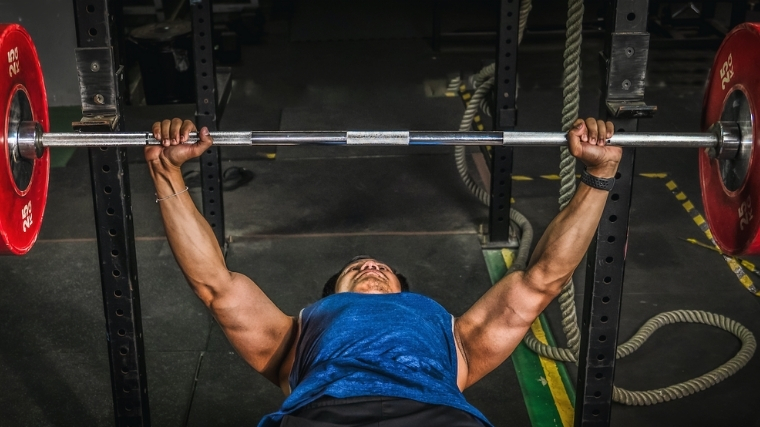The landscape of the strength training world is rapidly changing. Between emergent research and a commercially incentivized desire to find the “next big thing,” coaches and athletes are constantly looking towards new methods for improving their own performance and/or the performances of their clients.
Though it has gained a lot of traction in recent years, Velocity-Based Training (VBT) isn’t a novel idea in sport science — it has been used for several decades before its recent rise in popularity as a way of measuring athlete effort in the gym. However, VBT’s increase in prominence begs the question: does it have merit in the gym, or is it just another passing fad?

[Related: How Tempo Training Can Progress Your Workouts]
VBT: The What
VBT stands for “Velocity-Based Training,” but can also be identified as BVT, or “Bar Velocity Technology,” referring specifically to the devices and systems used to measure bar speed.
In physics, velocity is simply the rate of displacement of an object in space during a specific amount of time — usually being a loaded barbell. VBT aims to use the resulting data as a metric for monitoring athletic performance and making adjustments when they are needed.
To measure velocity, one typically attaches a device to the barbell (or another exercise implement). These devices record bar velocity, trajectory, or displacement, and then report that information to the user, who then uses it to guide their approach to training and programming.
The first widely used product in VBT was the Tendo, but the market has expanded wildly to include accelerometers like the MyoTest, linear position transducers such as GymAware, and even some laser optic devices like the Beast Sensor.
When utilized properly, velocity trackers are meant to help an athlete or coach understand more about the force being applied to the implement in question. This extra data can be highly useful in the right hands and with the right knowledge. An analogy made by Dr. Bryan Mann, a professor at the University of Miami who is widely regarded as an expert on VBT, summarizes it succinctly: “Normal sport science is a roadmap, but velocity training is a GPS.”
VBT: The Why
Intensity is one of the most common metrics coaches lean on when designing training plans for their clients. However, many of the traditional measurements of training intensity are subjective, meaning that they come from the perspective of the athlete themselves. The well-known RPE scale is a good example, wherein the subject performing the exercise rates their perceived difficulty on a scale of one to ten. VBT can be attractive to coaches and athletes because it provides an objective measure of intensity.
While perceived feedback about training difficulty is undeniably useful, it can also be unreliable, especially in the hands of novice athletes who tend to perceive everything as more difficult than it is. Bar velocity gives standardized, quantifiable feedback, attaching a numerical value — usually meters per second — to performance under load. While this information can be applied to broad program design, it appears to shine as a metric for daily readiness on the part of the athlete. Fluctuations in fatigue, alertness, and focus can sometimes strongly affect how well an athlete performs their workout, and adjustments often need to be made accordingly. The ability to measure how fast an athlete is moving a loaded implement can help coaches recognize how prepared their athletes are for the workout at hand, and make changes if needed.
Bar velocity can also serve as a motivator in team sport settings. Attaching an “effort value” to a set of back squats can foster a competitive atmosphere in the weight room for coaches or trainers who work with high school or collegiate athletes. Under proper supervision, VBT can push athletes to work harder against themselves or each other, producing stronger performances.

[Opinion: Train Easier in the Gym to Get Stronger]
VBT: Pros, Cons, & Limitations
Looking past some of the alluring promises made by velocity trackers, it’s important to remember that no principle or product in the strength training industry is infallible. While VBT certainly does appear to have strong applicability in some areas, it also has drawbacks.
The ability to measure athletic readiness or force output in real-time is a valuable tool to have in any coach’s repertoire. Using VBT to account for days when the athlete is more tired than usual can help them to potentially avoid injury situations or change intensity targets to better suit their ability to perform. Velocity trackers also gain points as a means of gauging intensity in novice lifters who tend to have a poor sense of their own effort ceilings, provided their technique is sound.
However, there are areas where VBT does fall short. While moving heavy loads fast is an invaluable skill for both strength sports and general athleticism, bar velocity itself isn’t the holy grail of training metrics. “Grinding” through a heavy max attempt will happen to everyone at some point in their program, or in the case of competitive powerlifters, on the competition platform itself. Athletes who go out of their way to always avoid slower, heavier sets in the name of maintaining high velocities may find themselves incapable of pushing through to the end when they need to.

[Related: How to Plan Group Training for Strongman]
Further, VBT can be somewhat incompatible with athletes who have inconsistent technique, especially in Olympic lifting. In a controlled, clinical setting, the movement should be as close to identical as possible each time to return the most reliable data — this is an unrealistic expectation, especially for novice lifters whose form can fluctuate significantly from rep to rep.
Application to Training
No training style or special gadget is a one-size-fits-all, and VBT is no different. Trying to force something to work in a context where it isn’t meant to may just end up creating more problems than it solves.
Before making any major changes to programming, it is advisable to simply collect data and get comfortable with new information. Once familiarized with using a tracking device during regular training, a coach or athlete could begin to apply the data to their workouts, whether by using it as a secondary RPE gauge or as a means of assessing force potential — or even fatigue — on a given day.
[Read More: Powerbuilding Workout Routine, With Tips from a CPT]
Unfortunately, without access to the technology required to record velocity data, the applications of VBT are limited. However, doing a quick vertical jump test could serve as a workable substitution, as it is a viable screen for CNS alertness if performed when the athlete is fresh.
Who VBT Could Be Right For
- Intermediate or advanced strength athletes who have consistent technique in their main lifts.
- Coaches who work closely with newer lifters who are performing straightforward, simple exercises.
- Instructors that work in small team-based settings looking for a way to foster a healthy, competitive atmosphere.
Who VBT May Be Wrong For
- Lifters currently performing a lot of non-specific training, as VBT loses value the further the athlete strays from their sport.
- Unsupervised or newer trainees, since inconsistencies in technique reduces the accuracy of the data.
- Coaches or trainers working in large group settings or instructing classes; it can become impractical to monitor a high volume of data at once and apply it in real-time.
Even though VBT has been around in some form for decades, its recent uptick in interest among coaches means that errors and misapplications are bound to happen. It is always best to err on the side of caution before fully committing to a new style of training or allowing one individual piece of technology to influence an entire program.
Wrapping Up
In an industry of rapidly evolving methodologies, where everyone claims to have discovered the “next big thing,” it can be all too easy to forget the building blocks of strength training and lose sight of what is proven to work. That said, new tech does occasionally come along that is truly worth a closer look.
While Velocity-Based Training has gained a lot of traction among coaches in recent years, it doesn’t seem to be the holy grail of strength science. Like most things in the fitness world, how it’s used is what defines its relevance. Slapping a gadget on the end of a barbell will not magically cause the athlete to move it faster, but — if the context of the data is understood and applied properly — it could be a very effective tool for pushing the limits of power in the gym.
Featured image: Rawpixel.com/Shutterstock